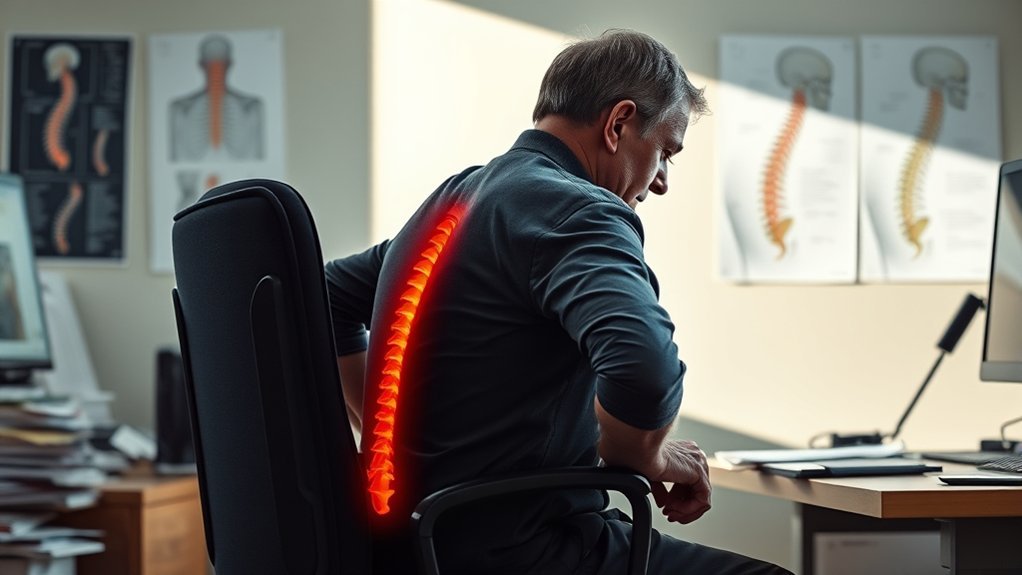If you’re struggling with back pain, you’re not alone. Many people experience discomfort due to various causes, like muscle strains or herniated discs. Factors such as age, obesity, and even stress can worsen your situation. Understanding these elements is essential for managing your pain effectively. But what specific strategies can help you find relief and prevent future issues? Let’s explore these insights together.
Common Causes of Back Pain

Back pain can stem from a variety of common causes that affect nearly everyone at some point in their lives.
Muscle strains are among the most frequent culprits, often arising from improper lifting or sudden movements. Herniated discs can also lead to significant discomfort, as they press on nearby nerves.
Poor posture, especially during long hours of sitting, can contribute to spinal misalignment, resulting in pain. Additionally, degenerative conditions like arthritis can wear down spinal joints over time, causing stiffness and soreness.
Even stress can manifest as back pain, due to muscle tension. Understanding these causes is vital for effective management and relief, allowing you to take proactive steps towards a healthier back.
Risk Factors Contributing to Back Pain

While many people experience back pain at some point, certain risk factors can increase your likelihood of developing this discomfort. Age is a significant factor; as you get older, your spine undergoes changes that can lead to pain.
Sedentary lifestyles contribute too, as lack of physical activity weakens your muscles and reduces flexibility. Obesity places extra strain on your back, while heavy lifting or repetitive motions can cause injury.
Additionally, psychological factors like stress and anxiety can exacerbate your perception of pain. Smoking decreases blood flow to the spine, hindering healing.
Understanding these risk factors is vital for taking proactive steps to reduce your chances of experiencing back pain and improving your overall spinal health.
The Impact of Poor Posture

Your posture plays an essential role in your overall spinal health, as poor alignment can lead to significant discomfort and long-term pain.
When you slouch or hunch over, you place extra strain on your spinal structures, which can irritate nerves and muscles. This chronic tension often results in stiffness, fatigue, and even headaches.
Research shows that maintaining a neutral spine position while sitting or standing can help alleviate these issues. Simple adjustments, like using ergonomic chairs or being mindful of your alignment, can make a substantial difference.
Remember, correcting your posture isn’t just about aesthetics; it’s a vital step towards preventing back pain and enhancing your overall well-being.
Prioritizing good posture is a proactive way to protect your spine.
Age-Related Changes and Back Pain
As you age, the natural wear and tear on your spine can lead to significant changes that contribute to back pain.
The discs between your vertebrae may lose hydration and elasticity, resulting in reduced cushioning and increased stress on the spine. Additionally, degenerative conditions like osteoarthritis can develop, causing inflammation and pain in the joints.
As we age, spinal discs lose hydration and elasticity, leading to increased stress and potential joint pain.
You might also experience muscle weakness or stiffness, which can compromise your posture and mobility. Hormonal changes can affect bone density, increasing the risk of fractures.
It’s essential to understand these age-related changes because they can impact your daily activities and overall quality of life. Recognizing these factors can help you take proactive steps to manage your back health as you age.
Effective Treatment and Prevention Strategies
To effectively manage and prevent back pain, it’s crucial to adopt a multifaceted approach that combines lifestyle changes, physical therapy, and medical interventions. Here are some strategies to reflect upon:
- Stay Active: Engaging in regular low-impact exercise strengthens your back and improves flexibility.
- Practice Good Posture: Maintaining proper alignment when sitting or standing can reduce stress on your spine.
- Look into Physical Therapy: A trained therapist can provide personalized exercises and manual therapy techniques tailored to your needs.
- Explore Pain Management Options: Consult your healthcare provider about medications, injections, or alternative therapies that may alleviate your pain.
Frequently Asked Questions
Can Back Pain Be a Sign of a Serious Medical Condition?
Yes, back pain can indicate a serious medical condition. If you experience severe pain, weakness, or other unusual symptoms, it’s vital to consult a healthcare professional for proper evaluation and guidance. Your health matters.
How Can Stress Contribute to Back Pain?
Stress acts like a heavy backpack you carry, tightening muscles and straining your back. It leads to tension and inflammation, making you more susceptible to pain. Managing stress can help lighten that load and ease discomfort.
Is There a Link Between Diet and Back Pain Relief?
Yes, your diet can impact back pain relief. Consuming anti-inflammatory foods like fruits, vegetables, and omega-3 fatty acids may help reduce inflammation and support healing, while processed foods can exacerbate discomfort. Prioritizing nutrition’s role is essential.
Are There Specific Exercises to Avoid for Back Pain?
Yes, you should avoid exercises that strain your back, like heavy lifting, deep squats, or high-impact activities. Instead, focus on low-impact movements to promote strength and flexibility while reducing the risk of injury.
When Should I Seek Professional Help for Back Pain?
When your back pain feels like a storm brewing, seek professional help if it persists beyond a few weeks, worsens, or is accompanied by numbness, weakness, or fever. Your health deserves timely attention and proper care.
Conclusion
In understanding back pain, you’re not alone—many face similar challenges. By recognizing the common causes and risk factors, you can take meaningful steps towards relief. It’s true that improving posture and staying active can greatly reduce discomfort. Remember, addressing both physical and psychological elements is essential. So, listen to your body, and don’t hesitate to seek professional advice. With the right strategies, you can reclaim control over your back health and enjoy a more active, pain-free life.
